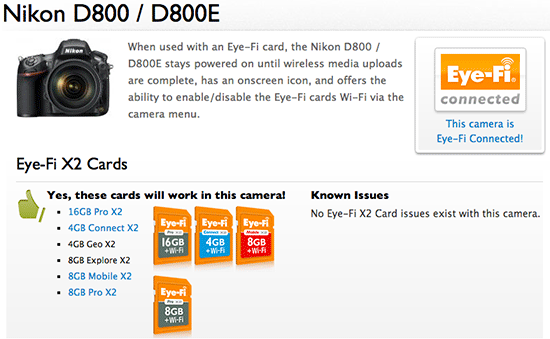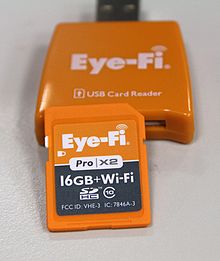Eye Fi Connect X2 Raw Hack

Apr 30, 2010 Where the Pro X2 gets the nod, though, is in what Eye-Fi calls the 'X2 Engine,' a three-pack of features that includes 802.11n support, Class 6 SD performance, and a nifty feature coined Endless. Yes, I shutdown the other eye-fi manager. And when I run the python server with no internet I see the output from the server seeing the eye-fi card connect but it never uploads any photos. I'm guessing it has to do with DNS because of the earlier comment had to alter my DNS so that api.eye.fi pointed to the server. March 31, 2009 at 10:35 AM. SONY α700にEye-Fi Pro X2を刺して、RAWをMacへ、JPEGをiPadへ転送してみました。 使用機材: Sony α700(cRAW+JPEG L) Eye-Fi Pro X2 PhotoFast CR-7000 CF-SD変換アダプタ.
The Eye-Fi Connect X2 ($49.99 direct) is a 4GB memory card for digital cameras. It features a Wi-Fi modem, compatible with 802.11n networks, that makes it possible to wirelessly offload photos from your camera to your computer, Android, or iOS device. You can also configure the Eye-Fi card to upload photos to photo sharing sites, including Flickr, Picasa, and Facebook.
Most current cameras are compatible with Eye-Fi cards, but if you have an older model you'll want to check on its compatibility. Using the card eliminates the hassle of connecting your camera to your computer via an often-proprietary cable, or removing the SD card for use in your PC's card reader. Eye-Fi also markets the Mobile X2 ($79.99, 4 stars) and Pro X2 ($149.99, 4 stars) memory cards, both of which hold up to 8GB of photos. Save the difference in capacity, the Mobile X2 offers the same feature set as the Connect X2. The Pro X2 adds support for Raw images, automatic geotagging, and Wi-Fi hotspot access.
Eye-Fi Connect X2
Bottom Line:
Please enable JavaScript to view the comments powered by Disqus.blog comments powered by Disqus
- Pros
Easy to use. Quick, automatic image transfer. Cloud storage. JPG and video support. iOS, Android, and Windows Phone compatibility.
- Cons
Slower than top-end memory cards. Lacks some advanced features. Some video formats not supported. Cloud service costs extra.
- Bottom Line
The Eyefi Mobi is one of the simplest ways to transfer photos from your camera to your phone. It's not as full-featured as some other Eyefi cards, but it's a lot easier to use.
If you've used Eyefi cards before, you're familiar with the concept behind the Mobi ($49.99, 8GB). Aside from its bright orange design, it looks like a standard SD memory card, and it works like one. But in addition to storing your photos, it has built-in Wi-Fi. This lets you transfer photos from your camera to your iOS, Android, or Windows Phone device via a free app, and if you opt to pay for the Eyefi Cloud service, it will also sync photos between your phone and tablet, and copy them to the Web so you can view them in a browser. Other Eyefi cards, like the Pro X2, support Raw transfer and other advanced functionality, but they require you to spend time setting them up and, if you ever want to change the functionality, it's back to the computer to reconfigure the card. The Mobi makes it truly simple to transfer photos from your digital camera to your phone, so it earns our Editors' Choice award.
- $79.99
- $149.99
- $99.99
There's an elegant simplicity in the Mobi. It just works. To get started you just need to download the free Eyefi Mobi app from the iOS, Android, or Windows Phone app store. Entering the printed code that is included with the card adds a network profile for it to your phone, so you won't have to type in a password for use. If you're away from a known network your phone will automatically connect to the Eyefii card when you launch the app, but if you're connected to your normal network you'll have to go into settings and switch to the Eyefi network in order to start downloading photos. Downloads are automatic, and pretty quick.
The Mobi can only transfer JPG files—not Raw—but if you shoot Raw+JPG it will have no trouble transferring the JPGs and ignoring the Raw images. Photos are transferred at full resolution. Videos can also be transferred, but you'll get an error message if the video format isn't supported by your phone. My iPhone 5 can't handle the AVCHD format that Sony D-SLRs use, but an MP4 file transferred without issue in my tests.
Eyefi Cloud
The Mobi card includes a three-month trial of the Eyefi Cloud service, which is priced at $49 per year if you opt to continue using it. The service automatically uploads all of your photos to the Web, so you can view them via a browser. Once they're online, it has a few more tricks up its sleeve. If you've got multiple handheld devices—whether they're cell phones or tablets—Eyefi Cloud will automatically sync your photos with them. Rather than wasting space with full-resolution shots, it downsizes to match the device resolution before copying them over. And once you've uploaded photos to the Eyefi Cloud, they'll be downsized and sent back to the phone to which they were originally transferred at its screen resolution. Minimizing photos stored on your main device or tablet will do the same, saving space. Full-resolution images will always live on the Eyefi Cloud, and will remain stored on the card until you delete them. If you're concerned about cellular bandwidth, you can set files to upload only when connected to Wi-Fi.
The design of the service allows for multiple cards to be registered to one account, and even split across devices. If you've got a picture-taking family, you could register a card with your phone, and have another card registered with your spouse's. As long as you're using the same Eyefi Cloud account, everything you shoot and transfer over will sync between your devices. And it doesn't matter if you've got a mixture of Android and iOS devices—the cloud service handles that scenario with no difficulties.
If you've used the older Eyefi app previously, you'll notice one big difference: The Mobi app doesn't automatically add images to your phone's image library. You can tweet, email, or post a photo to Facebook directly from the app, but if you want to do any sort of editing in an app like Photoshop Express or VSCO, or post to Instagram, you'll need to save the image to your Camera Roll first.
If you want to get images that you've shot with your phone, or images that you've edited in an app, to the Eyefi Cloud, there is a setting to import new images from your Camera Roll into the Mobi app. If you turn it on it only looks for images going forward; your entire backlog of shots won't transfer over. I did find it a bit of a chore to export and then import shots, but keeping the images separated from the main Camera Roll is likely required in order to facilitate the resolution reduction feature.
Deleting an image sends it to a trash bin folder, but it doesn't go away until you empty the trash. That's one way to cull unwanted shots from your photo timeline. If you'd prefer not to file photos away in a trash bin that is one click from being emptied, you can manually add images to photo albums. Album organization tools are minimal; there's currently no way to reorder images, so take care in the order in which you add them.
You also can't reorder photos in the photo stream view; it's always in date order. But you can change the points at which splits between groups of photos occur; and you can rename groups of photos from the default (which is the date) if you prefer the photostream approach to the album approach. Changing the split points is another function that's only available via a Web browser.
You can also add tags to photos. These can include the names of the people in the photo, the location at which they were captured, or anything else you'd like to use to filter through photos. Tags will automatically sync between devices, even if you were offline when adding them, and can be added or edited regardless of whether you're using the app or a browser. Eyefi Cloud also lets you share photos with your friends and family via email. Images need to be in an album to share them in this manner. You can add images to the album and anyone with whom you've shared it will receive an email update about the new photos.

Card Performance and Conclusion
The only real sticking point with the Mobi is its speed. If you love the burst mode on your D-SLR, you're likely to be disappointed by the Mobi's write speeds. I tested it with the Sony Alpha 77, which approaches 12 frames per second, to see how long it takes to write full bursts to the card. The Mobi took 26.6 seconds to record an 11-shot Raw+JPG burst, 22.3 seconds for an 12-shot Raw burst, and 16 seconds for a 13-shot JPG burst. The SanDisk 95MBps memory card we use as the baseline for testing all the cameras that come through our labs, fared much better: 10.4 seconds for Raw+JPG, 7.5 seconds for Raw, and 9.5 seconds for JPG.
Still, there's a lot to like about the Eyefi Mobi. It's an SD card, and it does the one thing that an SD card is expected to, but it also adds Wi-Fi to nearly every camera on the market (Eyefi maintains a list of compatible cameras). If 8GB isn't enough storage, there are also 16GB and 32GB ($99.99) versions available. It's simple to set up, and it actually benefits from not offering the plethora of unnecessary options that make the Pro X2 such a hassle to configure. You just need the card and a smartphone; there's no need to install anything on your computer. If you opt to use the Eyefi Cloud service over the long term you'll be on the hook for an annual fee, but the Mobi will continue to work without a subscription—it just won't sync to multiple devices automatically.
The Mobi isn't a great choice if you shoot action with a camera that supports high frame rates, as it's not the fastest card in the world. But if you want to share photos on social networks, aren't satisfied with the image quality that your phone camera provides, and aren't ready to buy a newer camera with built-in Wi-Fi, then the Mobi is for you. It takes all headaches out of setup and makes it quite simple to transfer photos from your digital camera to your phone. It's one of the best Wi-Fi camera add-ons we've used, and easily earns our Editors' Choice award.
Eyefi Mobi (8GB)
Eye Fi X2 Utility
Bottom Line: The Eyefi Mobi is one of the simplest ways to transfer photos from your camera to your phone. It's not as full-featured as some other Eyefi cards, but it's a lot easier to use.
